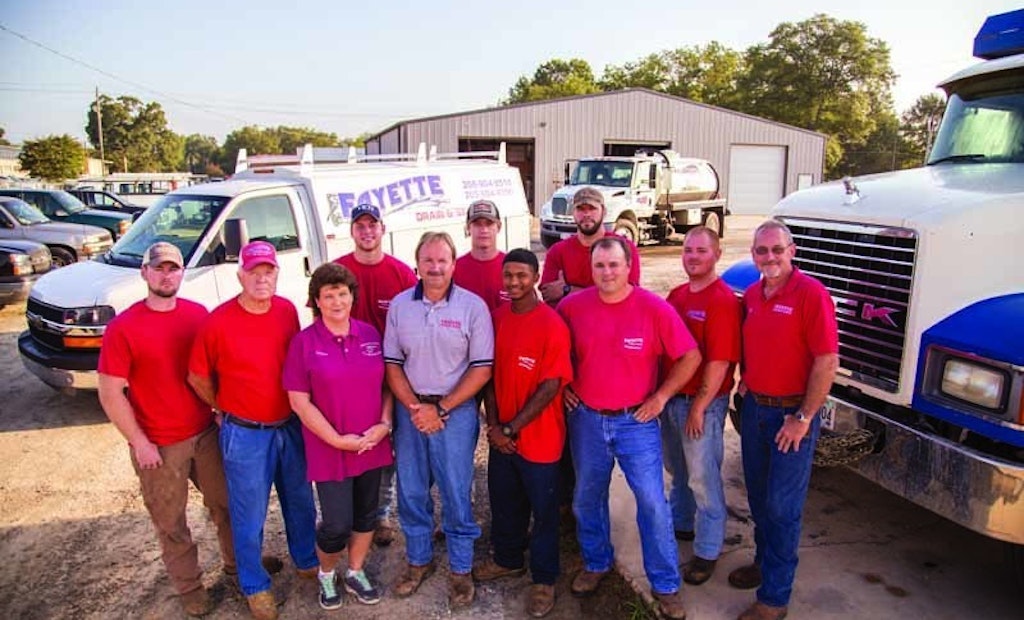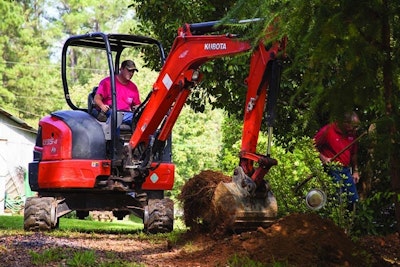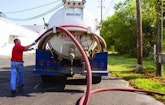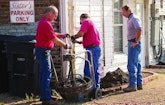
Interested in Trucks?
Get Trucks articles, news and videos right in your inbox! Sign up now.
Trucks + Get AlertsSeptic service contractors who doubt whether expanded drain cleaning services can mesh well with their existing pumping operations would do well to consider the experience of Mark Vice, the owner of Fayette Drain & Sewer Service Inc., based in Fayette, Alabama.
Vice started his company in 2000 by primarily focusing on unclogging drains. But a few years later he started pumping out septic tanks and grease traps, for several reasons. First, he was familiar with pumping septic tanks from a previous job. Second, there was only one other competitor in the area at the time. Third, the profit margins were good. And last but not least, he wanted to diversify his business base and stay busy.
“Fayette is a small town, so to survive you have to do a little bit of everything,” says Vice, who co-owns the company with his wife, Melissa. “So if it has water running through it, we go after it. … The thought of calling someone else to do something that I can provide to our customers is awful.”
DIVERSIFIED SERVICE
Today, Fayette Drain receives about 35 percent of its revenue from septic system and grease trap related services (including septic system installations), about 35 percent from drainline work, and the rest from plumbing services. And thanks to its diversified customer base, the company has grown steadily since its inception.
Fayette Drain now employs 12 people and owns a sizeable fleet of equipment that includes two vacuum trucks, two mini-excavators, a trailer-mounted water jetter, numerous drain cleaning machines and several pipeline inspection camera systems.
“I bought a used pump truck for $20,000 in 2002 and it’s still running,” Vice says. “There’s no telling how many thousands of dollars it has earned.”
Like every major equipment purchase Vice makes, he approached the vacuum truck investment with caution. “I’m always sure I have the business before I buy equipment,” he says. He started out by asking the owners of chain fast-food restaurants if they’d hire him to clean their grease traps if he bought a vacuum truck.
After he received verbal commitments from about a dozen businesses, he bought the truck.
“I put the math together and figured out how many customers it would take to enable me to make the payments,” he explains. “At that point, I figured any septic work would be a bonus.
“I knew how to do it and I knew there was a market for it,” he says of the pumping service. “I always had intended to do it, but I had to wait until I felt comfortable enough to make that investment.”
PERSEVERANCE PAYS
There was a time when buying trucks and equipment seemed like a pipe dream to Vice, who worked in a cotton mill for about 11 years before taking a job as a technician at a plumbing services company. After about four years working for another company, he decided to strike off on his own. At first he bought a van and drain machines.
“I did a lot of footwork – and a lot of praying,” he recalls. “I gave out 3,000 business cards my first year alone and asked people if there was anything I could do for them. I even painted someone’s house because we didn’t have enough plumbing work.” After three months, Vice had just $700 left in a checking account and was seriously questioning his business prospects.
Then fate intervened with a cold spell that generated a lot of work thawing frozen drainlines. After six months, Vice had made enough money to pay off an initial business loan. And things just took off. “Business just exploded,” he says. “People who I’d given business cards to just started calling with jobs.”
By 2008 the company employed six workers. Vice expanded into industrial cleaning and cleaning drainlines in apartment complexes. As the company’s reputation grew, he pushed for more commercial business.
“Residential work is great, but it’s very unpredictable,” he points out. “You might get 10 calls today and just two tomorrow and 15 two days from now. But apartment complexes and restaurants provide steadier work. You’re not going to pump a lot of septic tanks when it’s dry, but you’ll pump out grease traps whether it’s wet or dry.”
Vice says he tries to get commercial customers – especially the owners of restaurants and apartment complexes – to buy into the concept of scheduled maintenance cleanings because they’re easier to organize than scrambling to answer emergency calls. He does not ask for formal contracts, just verbal agreements.
“We want customers to be able to drop us at any time if they’re not happy with our work,” he explains. “We don’t want them to feel trapped by a written contract – just pleased with our service.”
EQUIPMENT MATTERS
To maximize revenue, Vice prefers to avoid subcontracting his workload. As such, part of his business model includes buying two of each kind of machine whenever possible. “If I have one excavator on a job, for example, and I get another call for a job that requires an excavator, I can’t stand the thought of pulling that first excavator off and sending it to the other job and having nothing for an emergency backup,” he says.
“When you’re in the emergency service business, that’s where you make your money,” he adds. “If there’s a whole building shutdown and a customer says ‘I need you now,’ I want equipment at my disposal so we can do timely and quality work. I don’t want to have to depend on someone else to be there for me when I need it.”
A wide array of equipment also ensures additional revenue streams. “After most jobs, I’ve made money off unclogging a drainline, I’ve made money on cameraing the line and if needed, I’ve made money digging up the drainline and replacing it,” Vice says.
The company currently owns two vacuum trucks. Abernethy Welding & Repair Inc. built Vice’s 2012 International truck. It features a 2,500-gallon steel tank and a Jurop/Chandler water-cooled pump. The other truck, a used 1991 International, features a 2,500-gallon steel Keith Huber Corp. tank and a 350 cfm pump from Power-Flo Pumps & Systems.
The company also owns two Kubota Tractor Corp. mini-excavators, a Caterpillar Inc. backhoe/loader, two dump trucks (Mack and Chevy) with Ox Bodies dump bodies, a trailer-mounted US Jetting water jetter (4,000 psi at 18 gpm), three Chevrolet service vans with KUV bodies made by Knapheide Manufacturing Co., and two Chevrolet service trucks. Each service van is equipped with drain cleaning machines made by Duracable Manufacturing Co., a RIDGID SeeSnake pipeline inspection camera system, and a pipeline locator made by Pipehorn Utility Tool Co. Inc.
THERE WHEN YOU NEED US
Of course, all the machinery in the world isn’t worth much without also providing quality service. Vice says Fayette Drain ensures customer satisfaction through great employees and a rather simple philosophy: Always answer the phone.
So Fayette Drain contracts with an answering service from 5 p.m. to 7 a.m. “If people get an answering machine when they call, most times they’re probably going to call someone else,” he suggests. “You have to value every phone call because every time you miss one, you miss out on at least $100 in work.”
Vice says the answering service costs $160 per month, a cost he can make up with one additional septic pumping job. The decision to ensure customers talk to a live person any time they call is a no-brainer to someone savvy about the importance of customer care.
“It’s a great investment. When people can’t flush their toilet (because of a backup), they want someone and they want someone right away,” Vice explains. “So when they call, they want to talk to someone, not an answering machine.”











